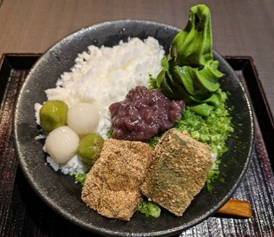Shaved Ice and Ice Cream
Yoshie Doi
 Matcha Awayuki Gokugyo Ice |
 Tiramisu Parfait Ice |
In August, Kyoto continues to experience scorching heat with temperatures reaching 39 degrees Celsius every day. This is the season when ice cream and other cold foods taste great, even inside an air-conditioned room.
There are documents that say that 1,300 years ago during the Nara period, ice was stored and presented to the emperor. The icehouse in Tenri City, Nara Prefecture, is the oldest icehouse in Japan. In the “Nihon Shoki,” it is confirmed that there was a position in charge of managing the icehouse in the reign of Emperor Kotoku. Although common people were not allowed to have ice in the summer, there were icehouses in Kyoto as well.
The remains of an icehouse can also be found in Nishigamo Himuro-cho, Kita-ku, Kyoto City. Located at an altitude of 450 meters, the temperature is 6 degrees Celsius lower than in the center of Kyoto City, and there seems to have been a lot of snow in the winter. The ice and snow from the winter was carefully stored in the icehouse until summer.
In Kyoto, there is a sweet that uses the word Himuro. Minazuki, eaten on June 30th as a summer purification ritual, is a sweet that has its roots in the ice shape of Himuro.
It is also written that in the Heian period, aristocrats enjoyed something similar to modern-day shaved ice. The reason shaved ice is said to have its roots in Japan may be because historical documents have been left behind. There are also theories that it may have originated in China or the Greek and Roman eras, but this is not certain.
It was only after the Meiji period that common people were able to access ice. Lacking the technology to make ice, people had to take the trouble to import it from Boston. It was expensive, costing three to five ryo (about 300,000 to 600,000 yen today) for a box the size of a beer crate or a mandarin orange crate. Nakagawa Kahei devoted his life to making this ice. He sold ice cut at Goryokaku in Hokkaido as “Hakodate ice,” and it seems that an ice boom began among common people.
Looking back at world history, it seems that in Europe, people used to eat this ice with ice cream and fruit on top.
The origins of ice cream are said to date back to ancient Greece and Rome, when people would pour syrup or fruit juice over ice to preserve food.
Alexander the Great had ice and snow brought down from the mountains, mixed with honey and fruit juice, and gave his soldiers cold drinks to drink in preparation for battle. Sherbet was also made by the Crusaders using Italian fruits and nuts. It seems that frozen desserts were developed in Europe in conjunction with the extreme conditions of war.
On another note, I remembered Miyamoto Musashi, who always carried “garlic miso” with him. Perhaps it’s the difference in climate between Japan, where fermented foods are a source of energy, and Europe.
About three years ago, I called every single shaved ice shop in Kyoto, wanting to visit them for a site visit for the Kyoto Food Story course. I asked 30 shops that I was interested in if I could visit them, but I remember giving up because it was difficult to make natural ice and prepare enough shaved ice for the students during the peak season in summer.
In Kyoto, Japanese sweet shops are offering delicious shaved ice with a Japanese sweet twist, and people are lining up to try them. Luxurious shaved ice with red bean paste, matcha, and fruit are also available. The super luxurious shaved ice made with a whole melon, costing 9,500 yen, is perhaps the most expensive shaved ice in Kyoto. It’s probably best shared by a few people. Please enjoy your favorite shaved ice in the hot summer.
The end of document
Translated by Masami Otani
